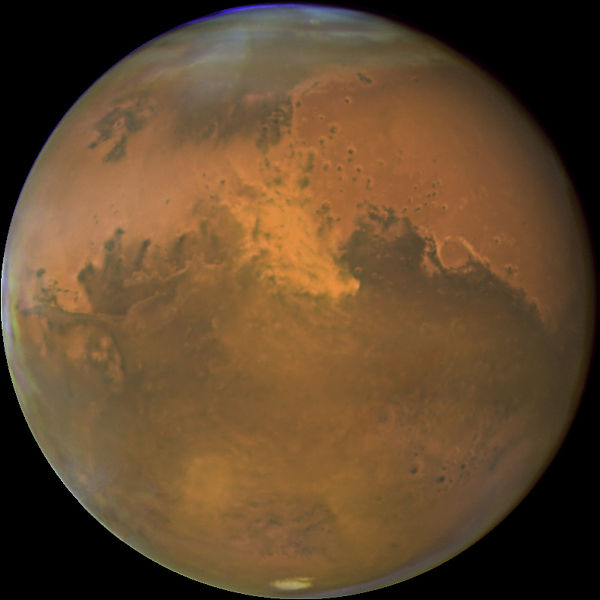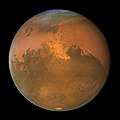Fitxer:2005-1103mars-full.jpg
Aparença

Mida d'aquesta previsualització: 600 × 600 píxels. Altres resolucions: 240 × 240 píxels | 480 × 480 píxels.
Fitxer original (800 × 800 píxels, mida del fitxer: 232 Ko, tipus MIME: image/jpeg)
Historial del fitxer
Cliqueu una data/hora per veure el fitxer tal com era aleshores.
| Data/hora | Miniatura | Dimensions | Usuari/a | Comentari | |
|---|---|---|---|---|---|
| actual | 17:52, 19 juny 2009 |  | 800 × 800 (232 Ko) | Tryphon | Higher resolution. |
| 02:21, 1 gen 2006 |  | 700 × 700 (34 Ko) | Pringles | NASA's Hubble Space Telescope snapped this picture of Mars on October 28, within a day of its closest approach to Earth on the night of October 29. Hubble astronomers were also excited to have captured a regional dust storm on Mars that has been growing |
Ús del fitxer
La pàgina següent utilitza aquest fitxer:
Ús global del fitxer
Utilització d'aquest fitxer en altres wikis:
- Utilització a af.wikipedia.org
- Utilització a bg.wikipedia.org
- Utilització a el.wikipedia.org
- Utilització a en.wikipedia.org
- Utilització a en.wikiquote.org
- Utilització a en.wikiversity.org
- User:Marshallsumter/Radiation astronomy1/Planets/Sciences
- User:Marshallsumter/Radiation astronomy2/Reds
- User:Marshallsumter/Radiation astronomy/Chemistry
- User:Marshallsumter/Radiation astronomy1/History
- Solar System, technical/Classical planets
- User:Marshallsumter/Keynote lectures (draft)/Meteor radiation astronomy
- User:Marshallsumter/Radiation astronomy1/Planets/Classicals
- Draft:Original research/Planets
- User:Marshallsumter/Radiation astronomy2/Visuals/Quiz
- User:Marshallsumter/Rocks/Rocky objects/Astronomy
- User:Marshallsumter/Radiation astronomy/Courses/Principles/Hourly 2
- User:Marshallsumter/Radiation astronomy/Courses/Principles/Midterm quiz
- User:Marshallsumter/Radiation astronomy/Courses/Principles/Final quiz
- Titan/Quiz
- User:Marshallsumter/Rocks/Rocky objects
- Draft:Enceladus/Quiz
- Moon/Quiz
- Stars/Sun/Heliology/Quiz
- Earth/Quiz
- User:Marshallsumter/Radiation astronomy/Clouds
- User:Marshallsumter/Radiation astronomy/Cryometeors
- User:Marshallsumter/Radiation astronomy1/Lithometeors
- Stars/Reds/Quiz
- Draft:Dione/Quiz
- User:Marshallsumter/Radiation astronomy2/Scattered disks/Quiz
- User:Marshallsumter/Radiation astronomy1/Kuiper belts/Quiz
- WikiJournal Preprints/Cryometeors
- Utilització a es.wikipedia.org
- Utilització a fa.wikipedia.org
- Utilització a fr.wikipedia.org
- Utilització a fr.wikinews.org
- Utilització a gn.wikipedia.org
- Utilització a hi.wikipedia.org
- Utilització a hu.wikipedia.org
Vegeu més usos globals d'aquest fitxer.

